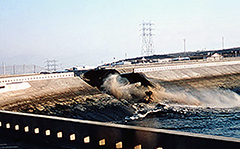Dams Disasters Disasters
The Baldwin Hills Dam disaster occurred on December 14, 1963, when the dam containing the Baldwin Hills Reservoir suffered a catastrophic failure and flooded the residential neighborhoods surrounding it. It began with signs of lining failure, followed by increasingly serious leakage through the dam at its east abutment. After three hours the dam breached, with a total release of 250 million US gallons (950,000 m3), resulting in five deaths and the destruction of 277 homes. Vigorous rescue efforts averted a greater loss of life.
The reservoir was located on a low hilltop in Baldwin Hills, Los Angeles, California. It was constructed between 1947 and 1951 by the Los Angeles Department of Water and Power directly on an active fault line, which was subsidiary to the well known nearby Newport–Inglewood Fault. The underlying geologic strata were considered unstable for a reservoir, and the design called for a compacted soil lining meant to prevent seepage into the foundation. The fault lines were considered during planning but were deemed by some, although not all, of the engineers and geologists involved as not significant.
The former reservoir is now part of the Kenneth Hahn State Recreation Area.
The failure of the Baldwin Hills Reservoir received an exceptional amount of attention from the civil engineering community and remains the subject of continuing interest. The reservoir had been conceived, designed, and built during and after World War II, a time when the pace of dam building was accelerating even as some disastrous dam failures were occurring, indicating a need for safer technologies. The builders of the Baldwin Hills dam, the Los Angeles Department of Water and Power, were aware of the difficult geologic conditions presented by the site and knew from past experiences, notably the catastrophic failure of the St. Francis Dam in 1928 in which over 400 people lost their lives, the serious consequences of a failure, even of a small reservoir in an urban setting. While dams were recognized as potentially dangerous, like nuclear technologies, they were also considered by Americans as a showcase technology—a means of fending off danger and spreading progressive American technologies and associated social benefits at home and abroad.
The Baldwin Hills dam designer, engineer Ralph Proctor, had also worked as an assistant civil engineer for the Los Angeles Department of Water and Power on the failed St. Francis Dam and had subsequently devised new methods of producing compacted earth fill in building its replacement. Proctor aggressively proceeded with the Baldwin Hills project even in the face of safety concerns and disagreements over important design details raised within his own department. More details
The reservoir was located on a low hilltop in Baldwin Hills, Los Angeles, California. It was constructed between 1947 and 1951 by the Los Angeles Department of Water and Power directly on an active fault line, which was subsidiary to the well known nearby Newport–Inglewood Fault. The underlying geologic strata were considered unstable for a reservoir, and the design called for a compacted soil lining meant to prevent seepage into the foundation. The fault lines were considered during planning but were deemed by some, although not all, of the engineers and geologists involved as not significant.
The former reservoir is now part of the Kenneth Hahn State Recreation Area.
The failure of the Baldwin Hills Reservoir received an exceptional amount of attention from the civil engineering community and remains the subject of continuing interest. The reservoir had been conceived, designed, and built during and after World War II, a time when the pace of dam building was accelerating even as some disastrous dam failures were occurring, indicating a need for safer technologies. The builders of the Baldwin Hills dam, the Los Angeles Department of Water and Power, were aware of the difficult geologic conditions presented by the site and knew from past experiences, notably the catastrophic failure of the St. Francis Dam in 1928 in which over 400 people lost their lives, the serious consequences of a failure, even of a small reservoir in an urban setting. While dams were recognized as potentially dangerous, like nuclear technologies, they were also considered by Americans as a showcase technology—a means of fending off danger and spreading progressive American technologies and associated social benefits at home and abroad.
The Baldwin Hills dam designer, engineer Ralph Proctor, had also worked as an assistant civil engineer for the Los Angeles Department of Water and Power on the failed St. Francis Dam and had subsequently devised new methods of producing compacted earth fill in building its replacement. Proctor aggressively proceeded with the Baldwin Hills project even in the face of safety concerns and disagreements over important design details raised within his own department. More details
